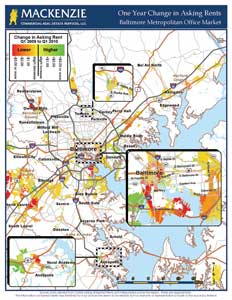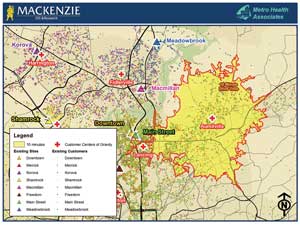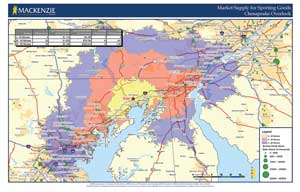Highlights
- Business Analyst Online and ArcGIS Mapping for SharePoint help real estate companies create accurate reports for clients.
- Information once presented in a 300-page binder enhances understanding when aggregated into map form.
- Real-time models can be built based on market conditions.
The golden rules for creating a successful shopping center—have a good location and strong anchor store—don't always apply in today's retail environment. Instead, the smallest nuances in a market can make or break a business. The success of shopping centers is based on generating the best mix of retailers and creating high-profile developments that are optimally aligned with neighborhood need and market opportunity. Finding and understanding the data to perform these functions in a traditional manner—through spreadsheets and by hand—can be difficult. Many commercial real estate owners and developers are finding that GIS opens the door to a new way of doing business.
SharePoint and ArcGIS Give United Properties an Edge
United Properties agents collaborate online to view information about different shopping center locations using Esri Business Analyst and SharePoint.
One shopping center owner, United Properties, provides a wealth of research to its leasing agents to help them develop critical insights into their trade areas. United Properties, with its sister company and leasing agent NorthMarq, of Minneapolis, Minnesota, is the owner of 20 shopping centers in the midwestern United States, providing a full range of commercial real estate services nationwide.
Too often, however, the agents didn't understand how best to leverage this information. "Giving a 300-page binder of data to our leasing agents just wasn't proving effective," says John Breitinger, vice president of NorthMarq.
The companies partnered with sister company Inetium to develop a program called re-lytics that offers proprietary research, analytics, and a Web-based toolkit supporting both leasing and asset management.
Re-lytics: 15 Minutes to a Great Site
After reviewing several options, the companies chose ArcGIS Server, ArcGIS Mapping for SharePoint, and Business Analyst Online (BAO) API. These were the only solutions they found that would provide access to the geographic datasets, internal information, and assessment tools that agents need to do their jobs, as well as a secure site to collaborate and share information. The team also uses geographic data from ArcGIS.com. With the software and data, leasing agents can now see all the information they need on a map to help their clients find the most appropriate space.
The re-lytics program surveys and assesses more than 134 categories of goods and services in each shopping center trade area. Using ArcGIS, the data can be organized to determine spending potential, competitive dynamics, and consumer preferences for every category of retail goods and services in the marketplace. The program is a quick and simple evidence-based approach since, as Breitinger points out, "Even the best insights are not useful if they aren't easy to use."
One component of re-lytics is a 15-minute tactical analysis. Users employ tools to quickly assess the market potential for a particular business, evaluate existing competition, and create custom marketing materials, including a comparison report that puts everything in context for a prospect. An agent begins by reviewing consumer spending and market potential reports to get a feel for the market potential.
Next, the agent uses the map-based tools to review current competition and property availability and see spatial relationships. The agent makes comparisons by selecting the trade areas to be compared by creating either a custom polygon or a radius or drive-time distance around an address. The agent then selects the categories that need to be considered for that particular retailer, such as key demographics, consumer expenditure, and employment information. A report is generated and made into an Excel spreadsheet. It only takes a few minutes for the agent to add information and a local perspective, such as anchor store and traffic information. A report like this is used to compare a retailer's existing sites to potential sites.
"Working with Esri software, we were able to provide custom materials to support each pitch, including comparison reports and very useful maps," asserts Breitinger. "This was a breakthrough in providing context for every decision. We are all overwhelmed with data. We have found GIS to be a rich platform to aggregate information from many sources and create much better insights and visualizations. This has resulted in more customer engagements and much more substantive discussions."
For more information, contact John Breitinger, vice president of retail services, NorthMarq (e-mail: john.breitinger@northmarq.com).
Nationwide Analysis for Real Estate Transactions
Edens & Avant, headquartered in Columbia, South Carolina, owns, operates, and develops community-oriented shopping centers in primary markets throughout the East Coast. More than 130 centers in 14 states make up its portfolio. The company's clients include regional and national retailers such as Fresh Market, Whole Foods, Publix, Starbucks, and Target.
Creating Healthy Shopping Centers
Whether a retailer is looking to open a new store, add a second store, or move across town, the company has to be ready with the correct information and a strong case for the retailer to move into an existing shopping center or a new development. Purchasing one-off reports to research each shopping center—the company's traditional way of doing business—becomes inefficient when dealing with hundreds of locations that have rapidly changing information like demographic data.
Combining city data with updated information through Bing Maps and Esri demographic data ensures that Edens & Avant has the most current information.
In addition, instead of banking on the promise of growth driven by the housing boom—the standard model a few years ago—developers must now develop projections based on less robust growth and more conservative economic projections. "Healthy shopping centers are the ones that are located in markets with a diverse workforce and good balance of daytime-to-household population," says David Beitz, director of GIS, Edens & Avant. As a result, the company needs to analyze, aggregate, and display accurate demographic information on a daily basis.
Edens & Avant turned to Esri Business Analyst Desktop software and BAO to help its clients make the most informed decisions. Clients can see and understand all information available for each shopping center location, including address, major roads, competition, population density, and growth. BAO is used to generate a customized six-page report annually for each shopping center that is then used by investment leasing and development group agents so they can better visualize and understand their markets. The software helps identify new markets that are similar to those in which the retailers are already successfully operating. If staff members need customized reports or maps, they can request them from the GIS group.
Integration with Bing Maps provides monthly updates to aerial, road, and hybrid (aerial with labels) maps. "Using GIS and Bing Maps, we are able to find locations fast," says Beitz. "Being able to view aerial images allows us to give a better context to our clients about location. This is particularly helpful when looking at larger areas."
Business Analyst streamlines operations. The company looks carefully at optimizing its shopping center portfolio by selling properties in secondary and tertiary markets and buying properties in primary markets with dense populations in core-based statistical areas. GIS is used to look at daytime population and income and population changes, among other information, and to research markets and assist in quickly leasing space by providing spatial information via maps and reports that uniquely characterize neighborhoods and are specific to each retailer.
"It is very important to know the demographics in order to find areas that will perform best in this new economic climate," says Beitz.
Edens & Avant can now serve its clients' needs internally without outsourcing to third parties. The ability to combine city building permit data ensures that Edens & Avant has the most current information for its clients. As a result, two planned grocery-anchored shopping centers are going forward in areas where population doubled even though residential construction recently slowed down. Being able to find and track this growth with Business Analyst allowed the company to minimize the carry time of the land and provide the shopping center sites based on the retailers' timelines. Concludes Beitz, "Without the information to support these decisions and an accurate and appropriate way to communicate it, these projects wouldn't have been as successful."
For more information, contact David Beitz, director, geographic information systems (e-mail: dbeitz@edensandavant.com).
Friedman Real Estate Group Invests in Analysis
Information is consolidated into one system, llowing Friedman Real Estate Group to better visualize and analyze CMBS data.
Friedman Real Estate Group, of Farmington Hills, Minnesota, a real estate company serving the Midwest, uses a solution based on GIS to help analyze and better organize Commercial Mortgage-Backed Securities (CMBS). Friedman had access to simple mapping tools and data for CMBS loans that allowed it to do analysis on behalf of its clients, but it was unable to do site analysis without a lot of work. Asking a few questions to get a more accurate picture of the investment performance of a particular area or property could take a few days and cost several thousand dollars.
Kirkshire Site Selection Services, a company specializing in technology solutions for Detroit-area real estate businesses, worked with Geographic Information Services, Inc, an Esri partner, to create the solution with ArcGIS Server using an ArcObjects component framework. The new system was created in two weeks.
Says Ian Burnstein, Kirkshire's owner, "The most exciting thing for me was helping Friedman implement a solution that someone with very little technology experience could use. We had to simplify a very complicated procedure so it would be a onetime, up-front expense instead of several thousand dollars each time they asked us to do an analysis."
GeoRSS Gives an Accurate Picture of the Market
Friedman uses a subscription-based service for the CMBS data from Investcap Advisors LLC. Investcap can define its own criteria to create more than 50 data filters, providing Friedman with a way to scrutinize underlying loan and property characteristics. This data is available in a GeoRSS, which is loaded into ArcGIS Server; queried; and segmented by the most relevant criteria for each market situation, such as distressed or performing assets. Analytic real-time models are then built based on market conditions. Dots are created on the map using Adobe Flex and deployed on cross-platform Internet applications based on the Adobe Flash platform using ArcGIS Web Mapping API for Flex. Because different executives want to see different data, they now have the ability to define their own criteria and queries.
In one scenario, the distressed asset group of a real estate firm in Michigan is looking for properties in Florida to represent or broker. A simple query returns all the distressed assets in that state that match the firm's core competencies—for example, retail and multifamily residential units. Displaying these results on a map reveals several clusters of these distressed assets in the Miami area. After choosing the properties of interest, the analyst runs demographic reports of the properties to better understand why there was a failure or a success. Was it due to the general market condition, bad financing, or mismanagement? For a real estate company, understanding these variables can be a key to success.
7:49 PM | 0
comments | Read More















